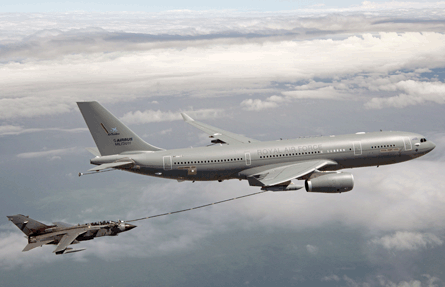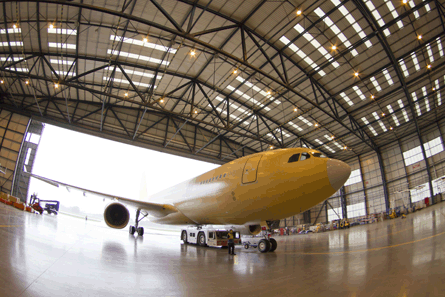While the UK's Strategic Defence and Security Review (SDSR) was dominated by spending cuts, the process did leave unscathed a massive project to introduce a new fleet of in-flight refuelling aircraft.
One of two Spanish-modified Airbus A330-200-based Future Strategic Tanker Aircraft (FSTA) is on schedule for delivery to the Royal Air Force's Brize Norton air base in Oxfordshire in late October. Meanwhile, the first of 12 re-branded "Voyagers" to be prepared in the UK landed at Cobham Aviation Services' Bournemouth airport facility in Dorset on 26 August for conversion (below).
 |
|---|
© Cobham Aviation Services |
Prior to the publication of the SDSR in October 2010, speculation had been rife that the FSTA deal could be among the victims of defence secretary Dr. Liam Fox's spending axe, due to its roughly £13.5 billion ($21.7 billion) price tag. Instead, the document underlined the government's commitment to replacing the RAF's Lockheed TriStar and Vickers VC10 tanker/transports, and confirmed that operations with both types would end from 2013.
The Ministry of Defence's January 2004 selection of the AirTanker consortium to deliver new-build A330s broke step with a tradition of modifying used airliners or long-range bombers such as the Handley Page Victor as tankers. But due to the complexity of its private finance initiative funding model, it was not until March 2008 that a contract was signed for 14 of the aircraft, to be handed over between late 2011 and mid-2016.
 |
|---|
© QinetiqReceiver clearance trials between the FSTA programme's second modified A330 and a Tornado GR4 should conclude within weeks |
Airbus Military flew the first Voyager with tanker equipment installed from its Getafe site near Madrid, Spain, for the first time in September 2010, with a second example following a few months later.
The modification work adds roughly 10,000kg (22,050lb) to the airliner's weight, including the installation of about 60km (32nm) of additional wiring, 30-plus antennas to support military communication requirements and strengthening measures to allow for the carriage of additional freight.
The aircraft also gains 2D cameras and additional lighting to support tanker duties, plus an air-to-air refuelling mission console on its flightdeck.
Each of the 14 Voyagers will get Cobham Mission Equipment-supplied 905E hose-and-drogue refuelling pods installed beneath their wings, while seven will also have an 805E fuselage refuelling unit to support large aircraft types. These can respectively pass fuel at flow rates of up to 1,300kg/min (2,800lb/min) and 1,800kg/min using 27.4m (90ft)-long hoses.
 |
|---|
© Craig Hoyle/Flightglobal |
Cobham's 905E pod can deliver fuel at a maximum rate of 1,300kg/min |
The UK's selection of the A330 could perhaps once have been considered extravagant, due to the type's larger size than a rival offer using ex-British Airways Boeing 767s, and the aircraft that it will replace. But as shown by subsequent operations over Afghanistan and Libya, the availability of a bigger and multi-role tanker is now urgently required.
"When the plan was put together for this programme, the events of Afghanistan, the demands of the 'airbridge' and the challenges of the Libya operation were unforeseen," says Air Marshal Kevin Leeson, the UK's Chief of Materiel (Air).
Noting that VC10s are currently flying 10h sorties out of Akrotiri, Cyprus, and Trapani, Italy, in support of missions involving the RAF's Eurofighter Typhoons and Panavia Tornado GR4s over Libya, he points to the incoming type's operational promise.
"Its 4,000nm [7,400km] range while carrying 285 passengers and freight will allow the UK to respond to world events with great speed. Its 111 tonne fuel load will enable four Typhoons to fly 3,600nm. Voyager will also be able to stay on station around 1,000nm from its base for 4.5h and still be capable of providing 50 tonnes of fuel for other aircraft. These are truly 'gee-whizz' numbers."
Airbus Military is completing pre-delivery preparations in Getafe to its second Voyager, which is in the two-point tanker configuration. The aircraft is due to enter use at Brize Norton on 1 November, initially at the hands of four AirTanker-recruited crews, including commercial training captains for the A330.
Starting around February 2012, it will be used to support the conversion and competency training of the first-serving RAF personnel to transition to the type.
"The team at the MoD [Ministry of Defence] are working extremely hard to get the phasing of that handover to work," says Leeson, who adds that "2013 to 2014 is a very challenging time for us".
Referring to the ongoing military certification process to allow the Voyager's delivery, Leeson says: "It's challenging, it's tight, but the clearance process has been straightforward and going very well." This uses existing European Aviation Safety Authority certification for the commercial A330, plus inputs from Spain's Instituto Nacional de Técnica Aeroespacial military airworthiness authority, which supported earlier testing of the Royal Australian Air Force's A330 multi-role tanker/transport (MRTT).
 |
|---|
© CobhamThe first Voyager to be converted in the UK has arrived at Cobham's Bournemouth airport site |
"We start from not only an A330 baseline, but a certified tanker baseline," says AirTanker chief executive Phill Blundell. "The Voyager is different to the MRTT, but it has got a significant number of similarities as well." Blundell says AirTanker is "pretty much there with the certification of the tanker", having received a technical certificate for the Voyager modifications in late August. "We've got some tidying up to do, but the last two or three percent is always the most painful process."
Receiver clearance trials involving aircraft one and an instrumented Tornado from the MoD/Qinetiq Boscombe Down site in Wiltshire should also conclude within weeks. The arrival in Bournemouth of the programme's third aircraft came around one month ahead of schedule - and as Cobham opened its newly refurbished conversion centre. Capable of housing two A330s, the "Hangar 12" facility will be operational for at least the next five years.
The UK company expects work to last 12 months per aircraft initially, with additional manpower to be used to prepare fuselage refuelling unit-equipped examples. However, its target is to reduce this to around 10 months later in the programme, by implementing its own online operating framework.
This has been drawn up using the experience gained by approximately 20 Cobham staff, who spent the last two years in Getafe supporting the conversion of the UK's first two aircraft, and at least one additional A330 tanker for an overseas customer.
It will create roughly 100 new jobs to perform the work, including apprentices and graduates. Airbus Military will also keep a team of specialists in Bournemouth until the project's completion.
After arriving in the UK, aircraft three was placed into preservation mode, with its seats and auxiliary power unit removed.
 |
|---|
© Craig Hoyle/Flightglobal |
Strip activities will take three weeks to complete before work can begin on structural modifications and avionics additions.
The programme's fourth aircraft should arrive at the site during December, for conversion as a three-point tanker.
Cobham Aviation Services managing director Des Taylor points to the company's more than 75-year heritage in the air-to-air refuelling sector - and to its experience in converting several VC10s from the passenger to tanker configuration from 1992. "I have every confidence that this buy will be a repeat of that success," he says. The relationship with AirTanker also could run way beyond 2016, potentially through provision of some through-life support services for the Voyager.
Referring to the RAF's transition plan, Blundell says between six and eight Voyagers should be available to the service in 2013. Once introduced, the fleet will remain in operation for at least 25 years.
AirTanker will guarantee the availability of nine aircraft - including several at high readiness - and look to use any spare capacity available post-2015. This could be achieved through arrangements made with allies such as France, or by leasing aircraft to charter airlines. Blundell believes third-party demand for the A330 will continue for at least the next 20 years, but says the military market is a more attractive target.
"If you look across NATO and Europe, the capability that we're delivering to the RAF is remarkably scarce," he says. "I would be much more focussed on how we get 14 Voyagers operating as Voyagers in tripartite relationships."
Source: Flight International
















